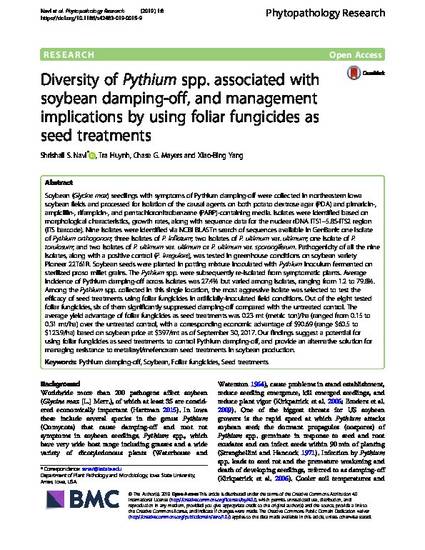
Soybean (Glycine max) seedlings with symptoms of Pythium damping-off were collected in northeastern Iowa soybean fields and processed for isolation of the causal agents on both potato dextrose agar (PDA) and pimaricin-, ampicillin-, rifampicin-, and pentachloronitrobenzene (PARP)-containing media. Isolates were identified based on morphological characteristics, growth rates, along with sequence data for the nuclear rDNA ITS1–5.8S-ITS2 region (ITS barcode). Nine isolates were identified via NCBI BLASTn search of sequences available in GenBank: one isolate of Pythium orthogonon; three isolates of P. inflatum; two isolates of P. ultimum var. ultimum; one isolate of P. torulosum; and two isolates of P. ultimum var. ultimum or P. ultimum var. sporangiferum. Pathogenicity of all the nine isolates, along with a positive control (P. irregulare), was tested in greenhouse conditions on soybean variety Pioneer 22T61R. Soybean seeds were planted in potting mixture inoculated with Pythium inoculum fermented on sterilized proso millet grains. The Pythium spp. were subsequently re-isolated from symptomatic plants. Average incidence of Pythium damping-off across isolates was 27.4% but varied among isolates, ranging from 1.2 to 79.8%. Among the Pythium spp. collected in this single location, the most aggressive isolate was selected to test the efficacy of seed treatments using foliar fungicides in artificially-inoculated field conditions. Out of the eight tested foliar fungicides, six of them significantly suppressed damping-off compared with the untreated control. The average yield advantage of foliar fungicides as seed treatments was 0.23 mt (metric ton)/ha (ranged from 0.15 to 0.31 mt/ha) over the untreated control, with a corresponding economic advantage of $90.69 (range $60.5 to $123.9/ha) based on soybean price at $397/mt as of September 30, 2017. Our findings suggest a potential for using foliar fungicides as seed treatments to control Pythium damping-off, and provide an alternative solution for managing resistance to metalaxyl/mefenoxam seed treatments in soybean production.
Available at: http://works.bepress.com/shrishail_navi/62/

This article is published as Navi, S.S., Huynh, T., Mayers, C.G. et al. Diversity of Pythium spp. associated with soybean damping-off, and management implications by using foliar fungicides as seed treatments. Phytopathol Res 1, 8 (2019). doi:10.1186/s42483-019-0015-9.